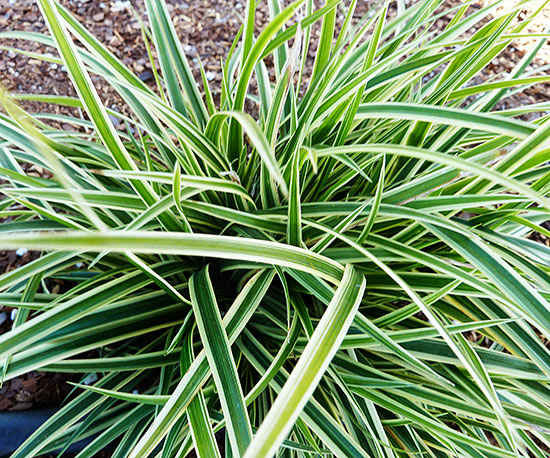






More than 2,000 Carex species grow wild in numerous habitats across the world, particularly in New Zealand, Japan, and the United States. This low-maintenance, deer-resistant group is well-suited for a wide range of garden sites including rock gardens and containers, perennial beds, borders, and native-plant gardens. They can also thrive in environments as different as dry shade and boggy areas alongside streams and ponds.
Foliage usually grows in tussocks or tufts of fine-textured or coarse blades, often upright and arching at the tips; some appear to have been tousled by a whirlwind. Leaf color varies from light to medium green, blue-grayishgreen, bronze, and caramel; many selections are rimmed or edged with contrasting white, silver, or yellow. Because the foliage is more or less evergreen, especially in mild climates, sedges provide much-needed winter interest where not covered by snow.
Greenish sedge flowers are seldom large or striking individually, but several of them cluster in showy spikes or dense heads to put on quite a display, such as black sedge. Others are inconspicuous, such as weeping brown sedge and blue sedge. Plants either carry male flowers on a part of the plant separate from the females, or females may be separated on the same spike. Fruits that follow are called nutlets.
The explosion in popularity of Carex species is due to their great variability and adaptability to so many site conditions. Gardeners have finally realized how useful sedges can be. Planting time varies by species. Generally, cool-weather sedges are best planted in fall. Warm-weather species including New Zealand hair sedge, Morrow's sedge, brown sedge, and plantain-leaved sedge tolerate either fall or spring planting with success. Leatherleaf sedge prefers spring planting.
With more than 2,000 separate species and multiple selections and cultivars, sedges range in height from creeping or prostrate to 4 feet tall or more. Whether in sun or shade, wet or dry, or rocky or fertile soils, sedges adapt to most conditions. Most thrive in soil that remains moist and does not desiccate in the heat of summer. Average garden soil is usually fine, although incorporation of moistureretaining organic matter at planting time is beneficial, as is summer mulch.
Learn more about growing and caring for sedge in our Plant Encyclopedia.
Increase sedges by dividing the plants in early spring. Usually small plants or plugs are available in local nurseries and garden centers for residential plants. Seed germination may be spotty and generally is only used on a large scale. Maintenance is confined to late spring, after frost is likely. Rake out the old dead leaves from the previous year or cut the tufts back to about four inches. Be aware that leatherleaf sedge does not like a haircut and is best just tidied up a bit to expose the new growth.
Sedges are suitable for almost any place you need to furnish. Some species make excellent groundcover plants. Adaptable, easy-care sedges have earned their place in residential gardens. No longer considered substitutes for ubiquitous ornamental grasses, they are appreciated now for understated interest and contrast to showier companions.
New Zealand hair sedge (Carex comans): Fine-textured bronze foliage; also tolerates part shade. 12–24 inches tall. 'Bronze' has more pronounced foliage color. 'Frosted Curls' has curly silver-green leaves. Zones 7–9.
Oak sedge (C. albicans): This native tolerates dry, full-sun conditions well. Dense upright tufts of bright green, quarter-inch arching leaves; showy flowers. 15–20 inches tall. Zones 4–8.
Golden sedge (C. elata 'Aurea'): Also known as 'Bowles Golden' sedge. Brilliant lemon-lime leaves droop at the tips. 24–30 inches. Also tolerates full sun. Zones 5–8.
Black sedge (C. nigra): Prefers wet feet; excellent as groundcover in rain gardens or swales. Clumps of grayish-green leaves. Foliage of 'Variegata' is edged with yellow. 6–9 inches. Zones 4–8.
Glaucous sedge (C. flacca): Tousled tussocks of fine, bluegreen leaves. Keep dry to control height. 6–24 inches. 'Burton's Blue' has slightly wider, very blue leaves. 'Blue Zinger' has blue-green leaves; tolerates drought and damp soils. Zones 4–9.
Blue wood sage (C. flaccosperma): Has dramatic 1– to 2-inch-wide blue-gray leaves. Native. 12–18 inches. Zones 5–9.
Tussock sedge (C. stricta): Native in sunny to partly shaded Northeastern wetlands. Dense tussocks of slender, glaucous leaves. Mass or use as groundcover. 3 feet tall. Zones 3–8.
Broadwing sedge (C. alata): This Eastern U.S. native is fine in part shade or full sun if water is sufficient. Tufts of slender, grassy leaves to 30 inches tall. Zones 4–8.
Copyright © www.100flowers.win Botanic Garden All Rights Reserved